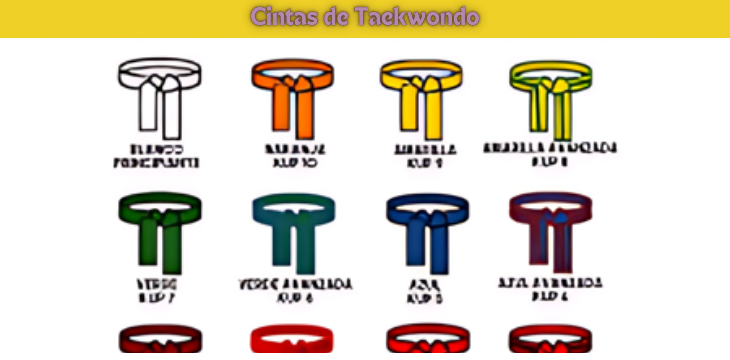Ever wondered what makes a taekwondo belt more than just a strip of cloth? The answer lies in the rich tradition and intricate symbolism of cintas de taekwondo. Whether you’re a newbie stepping into the dojang or a seasoned martial artist looking to refresh your knowledge, understanding the different colors and their meanings can deepen your appreciation for this ancient art. Let’s dive into the colorful world of taekwondo belts and uncover the stories and traditions behind each hue.
The Journey Through Cintas de Taekwondo
What Are Cintas de Taekwondo?
Before we get into the nitty-gritty, let’s start with the basics. Cintas de taekwondo, or taekwondo belts, are more than just a symbol of rank—they represent a martial artist’s journey, growth, and mastery. Each belt color signifies a different level of achievement and understanding within the taekwondo discipline. Here’s a quick rundown:
- White Belt: The beginning stage, symbolizing purity and a blank slate.
- Yellow Belt: Represents the seed of knowledge beginning to grow.
- Green Belt: Signifies progress and the growth of skills.
- Blue Belt: Indicates deeper understanding and the skyward aspiration for mastery.
- Red Belt: Denotes a high level of skill and the warning to opponents.
- Black Belt: The culmination of years of hard work, symbolizing expertise and the mastery of techniques.
The Meaning Behind Each Belt Color
Every color in the cintas de taekwondo spectrum carries a unique significance. Here’s a closer look at what each belt color symbolizes:
White Belt: The Starting Point
The white belt is where every taekwondo journey begins. It’s a symbol of purity, innocence, and the beginning of a new journey. Imagine a fresh canvas ready to be painted with skills and knowledge!
Yellow Belt: The First Signs of Growth
Just like the sun nurtures a growing seed, the yellow belt represents the initial growth and development in taekwondo. At this stage, practitioners start to learn basic techniques and forms, laying the foundation for more advanced skills.
Green Belt: Growth and Development
The green belt symbolizes further development and the blossoming of taekwondo skills. It’s a sign that you’ve begun to understand the fundamentals and are ready to explore more complex techniques.
Blue Belt: The Sky’s the Limit
The blue belt signifies a higher level of skill and a desire to reach new heights. Practitioners at this stage have a firm grasp of taekwondo techniques and are starting to refine their skills.
Red Belt: A High Level of Proficiency
Wearing a red belt indicates that you’ve achieved a significant level of proficiency and are close to reaching the top. It’s a symbol of warning to opponents, showing that you’re not to be underestimated.
Black Belt: Mastery and Beyond
The black belt is often seen as the ultimate goal, but in taekwondo, it’s just the beginning of a new journey. It represents mastery, discipline, and the endless pursuit of perfection. It’s a mark of respect and a testament to years of dedication and hard work.
How to Choose the Right Belt for Your Taekwondo Journey
Choosing the right cintas de taekwondo isn’t just about picking a color; it’s about reflecting your current level and aspirations. Here’s a simple guide to help you navigate the process:
- Start with the Basics: Begin with a white belt and focus on learning the fundamental techniques.
- Set Clear Goals: As you progress, set clear goals for each belt level. This will keep you motivated and on track.
- Seek Guidance: Consult with your instructor to ensure you’re ready for the next belt. They’ll provide valuable insights and feedback.
- Practice Regularly: Consistent practice is key to advancing through the belt ranks. Make sure to dedicate time to hone your skills.
- Embrace the Journey: Each belt color represents a milestone in your taekwondo journey. Embrace the learning process and enjoy the ride!
FAQs About Cintas de Taekwondo
How Long Does It Take to Progress Through the Belts?
Progression through the cintas de taekwondo varies depending on the individual, their dedication, and the school’s requirements. Generally, it takes a few months to a year to advance from one belt to the next.
Can I Skip Belt Levels?
Skipping belt levels is rare and usually only occurs under exceptional circumstances. Most taekwondo schools follow a structured progression, ensuring that students acquire the necessary skills and knowledge before advancing.
What Should I Do if I’m Struggling with a Belt Level?
If you’re having trouble with a particular belt level, don’t be discouraged! Seek additional help from your instructor, focus on your weaknesses, and practice regularly. Remember, progress takes time and patience.
Are There Different Belt Colors in Different Taekwondo Styles?
Yes, belt colors can vary between different taekwondo styles and organizations. While the core colors are similar, some schools may have additional or slightly different colors in their ranking system.
Conclusion
The world of cintas de taekwondo is as vibrant and diverse as the martial art itself. Each belt color tells a story of growth, dedication, and the journey towards mastery. Whether you’re just starting out or are a seasoned practitioner, understanding the significance of each belt can enhance your appreciation for taekwondo and its rich traditions.
So, next time you tie on your taekwondo belt, remember—it’s not just a piece of cloth; it’s a symbol of your journey, your progress, and your commitment to this incredible martial art. Keep training, stay motivated, and embrace the path to mastery!

